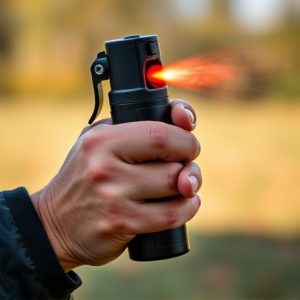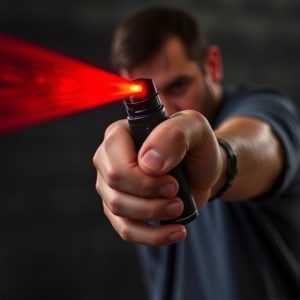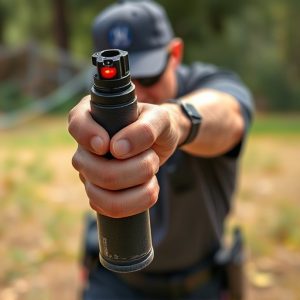Bear Spray vs Personal Pepper Spray: Police Crowd Control Choices
In crowd control, understanding the differences between bear spray and personal pepper spray is cruc…….
In crowd control, understanding the differences between bear spray and personal pepper spray is crucial for effective deployment and safety. Bear spray, potent and long-range, deters aggressive bears but may harm bystanders in crowded spaces. Personal pepper spray, designed for human self-defense, has a shorter range and targets individuals up to 4-6 feet away. The choice between these depends on the specific threat—bears or other humans—and requires strategic selection for optimal crowd management with minimal civilian risk. Law enforcement receives training to differentiate, handle, and apply these sprays safely based on situation assessment and de-escalation techniques.
“In recent years, the use of pepper spray by law enforcement agencies has sparked debates, especially with the rise in crowd control measures. This article delves into the world of pepper spray, exploring its various forms, including a close comparison between bear spray and personal pepper spray. We examine the legal and ethical dimensions of police usage, provide insights on effective crowd control strategies, and highlight critical safety precautions and training for officers. Understanding these aspects is crucial in navigating the complex relationship between law enforcement and community safety.”
- Understanding Pepper Spray: A Basic Overview
- Bear Spray vs Personal Pepper Spray: Key Differences
- Police Use of Pepper Spray: Legal and Ethical Considerations
- Effective Crowd Control Strategies with Pepper Spray
- Safety Precautions and Training for Law Enforcement Officers
Understanding Pepper Spray: A Basic Overview
Pepper spray, a powerful tool in crowd control, has become a ubiquitous presence in law enforcement arsenal. At its core, it’s a type of aerosol irritant designed to temporarily disable individuals by causing a burning sensation and temporary blindness. This disruption allows police to gain control over agitated or violent crowds, ensuring the safety of both officers and citizens.
While often used interchangeably, bear spray and personal pepper spray are distinct. Bear spray, designed for protection against aggressive bears, is generally more potent and has a longer range than personal pepper spray. Personal pepper spray, as the name suggests, is tailored for close-quarters self-defense against individuals. Understanding this distinction is crucial in knowing when and how to deploy these tools effectively for crowd control purposes, ensuring their use aligns with safety protocols and specific situations.
Bear Spray vs Personal Pepper Spray: Key Differences
Bear spray and personal pepper spray are both designed for self-defense, but they serve different purposes and have key differences. Bear spray is specifically formulated to deter aggressive bears and is much stronger than traditional personal pepper spray. It contains capsaicin, the active ingredient in chili peppers, mixed with other chemicals that can cause a bear’s eyes to water, its nose to tingle, and its throat to close up, temporarily incapacitating it. This type of spray has a range of around 20-30 feet and remains effective against bears for several minutes.
In contrast, personal pepper spray is designed for human self-defense against other humans. It’s typically less potent than bear spray and has a shorter range, usually only about 4-6 feet. However, it can still cause temporary blindness, coughing, and difficulty breathing for up to 30 minutes. Personal pepper spray is easier to carry and use in close quarters, making it a popular choice for individuals concerned about their safety in high-crime areas or during protests where crowd control measures are necessary.
Police Use of Pepper Spray: Legal and Ethical Considerations
The use of pepper spray by law enforcement agencies is a controversial topic that raises important legal and ethical questions. While it’s an effective crowd control measure, particularly in situations where non-lethal force is required, its application must be carefully regulated to prevent misuse and protect public safety. The debate often centers around the distinction between bear spray, designed for wildlife encounters, and personal pepper spray used against humans. Legal considerations vary by jurisdiction; some regions have strict guidelines on when and how police can deploy such agents, focusing on proportionality and necessity.
Ethically, the discussion delves into issues of consent, excessive force, and potential harm to bystanders. The specific type of pepper spray matters; bear spray has a much wider radius of effect, making it more likely to affect innocent people in crowded spaces. Personal pepper spray, while more targeted, still poses risks and must be used judiciously. Transparency and accountability in police practices are crucial; officers should be trained to use these agents responsibly, minimizing the impact on those not directly involved in a confrontation.
Effective Crowd Control Strategies with Pepper Spray
In crowd control situations, law enforcement agencies often turn to pepper spray as a powerful tool for managing and dispersing large gatherings. However, it’s crucial to understand that there are different types of pepper spray designed for specific purposes. Bear spray, for instance, is formulated to deter aggressive bears but may not be the most effective against human crowds due to its broader range and higher concentration. On the other hand, personal pepper spray is tailored for close-quarters crowd control, offering a more targeted approach with a shorter range to minimize bystander impact.
The strategic use of either type depends on the nature of the gathering. Personal pepper spray excels in confined spaces or when dealing with unruly individuals who pose an immediate threat. Its precision allows officers to disable specific agitators without affecting the broader crowd. In contrast, bear spray is better suited for outdoor scenarios where a wider area needs to be secured quickly, as its strong scent can deter potential threats over a larger radius. Choosing the right pepper spray type ensures effectiveness and safety in managing diverse crowd control situations.
Safety Precautions and Training for Law Enforcement Officers
Law enforcement officers undergo rigorous training in crowd control tactics, including the safe and effective use of pepper spray. This training emphasizes the importance of understanding different types of bear spray vs personal pepper spray, their active ingredients, and the respective impact areas to minimize risks for both officers and bystanders.
Officers are taught to assess the situation, choose the appropriate spray type based on crowd behavior and environment, and employ it in a targeted manner. Safety precautions include wearing protective gear, ensuring proper ventilation, and having a clear understanding of de-escalation techniques to avoid unnecessary harm. Regular practice sessions help officers maintain proficiency and adapt their strategies as new types of pepper spray emerge.
In conclusion, while both bear spray and personal pepper spray serve as effective crowd control tools, their distinct properties necessitate a nuanced understanding. Bear spray, designed for outdoor encounters with bears, offers a broader reach but requires careful handling due to its slower reaction time. Personal pepper spray, on the other hand, provides a quicker and more targeted impact, making it ideal for close-quarters situations. For law enforcement officers, proper training and safety precautions are paramount when employing these agents, especially considering the legal and ethical implications. By understanding the differences and implementing strategic usage, police can maintain public safety while respecting individual rights, ensuring that crowd control measures remain proportional and justifiable.


